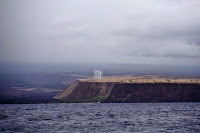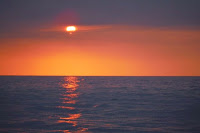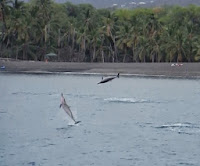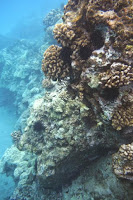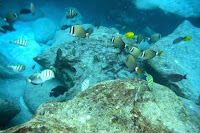[Kyle]We rented a vehicle again. This time it was a four-wheel drive, so we could take the very steep road up to the summit of Mauna Kea.
My thought for most of the trip to Hawai’i was that we couldn’t sail all the way here and not go to the top. Maryanne pointed out that there were lots of other goals, like beaches and volcanoes and petroglyphs to be seen, also competing for our rapidly diminishing time in Hilo and requiring a car. When she found out four-wheel drive prices are triple, she really lost interest. She made a good argument. Mine was just that I didn’t care if it was cost effective, I really wanted to go. I think she eventually gave in because she knew I would have us trying to walk there from the boat otherwise as is our custom.
Per Wikipedia: Mauna Kea stands 13,803 ft (4,207 m) above sea level, its peak is the highest point in the U.S. state of Hawaii. However, much of Mauna Kea is below sea level; when measured from its oceanic base, its height is 33,100 ft (10,100 m)—more than twice Mount Everest's base-to-peak height of 11,980 to 15,260 ft (3,650 to 4,650 m)
As a bonus, our friends from Hilo, Doug and Catherine, had never been to the top either as none of the vehicles they have had during their tenure has been suitable.
After being treated to a nice Thai curry take-out, we all piled in, along with snacks and warm clothes and headed upwards. We stopped for an hour or so at the visitor’s information center at 9,200 feet (2,800 meters) to go for a short hike to a nearby viewpoint in order to help acclimate ourselves to the altitude.


The rare and fragile Mauna Kea silversword, Argyroxiphium sandwicense
Almost as soon as we started hiking, we were enshrouded in thick fog. So much for the view! We instead turned our attention to the fascinating geology at our feet. Although there was a whole ecosystem of plants and animals that have taken root since the land was formed, erosion is a very slow process and the place still feels as if the lave had only just stopped cooling.


Acclimatising to the altitude with a short hike up a cinder cone
We bundled up, engaged the four-wheel drive and headed to the summit. About halfway from the visitor’s center, we climbed out of the fog into a brilliant clear sky. The dry landscape above the tree line made us feel like we were climbing Olympus Mons on Mars.



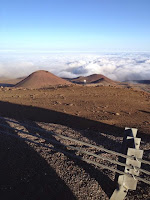
The road up, and up, the mountain..
We parked the car between a couple of the observatories and got out for a look. Walking along the access road, it’s impossible not to be impressed by the collection of some of the world’s largest observatory for optical, infrared, and submillimeter astronomy. I was surprised by how small most of them were. I guess I had pictured something the size of a planetarium with a few offices to one side. Instead, most seemed only big enough to hold the telescope, plus maybe a small desk underneath.


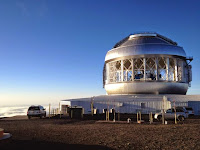
The views from the top - that is some FANCY equipment!
Me being me, and Maryanne being Maryanne, we had to do the short hike up a steep path to the true summit of Mauna Kea, separated from the observatories by a small crater and standing at 13,808 feet (4,208 meters). Although I have climbed a few mountains over 14,000 feet and as a kid growing up in Colorado, it’s been a very long time since I have exerted myself at anything near that altitude in a very long time. I haven’t even been in an airplane for a while, with its equivalent pressure altitude of 8,000 feet. Although we could definitely feel the strain of each step more than at sea level, I was actually surprised we weren’t more tired. Perhaps it was the cool air, perhaps it was the view, but we almost had a spring in our step as we topped the mountain.




A walk to the actual top - for the views!
Wow! Although most of the Big Island was beneath the clouds, the sea was visible below. Most of the 14,000 foot mountains in Colorado rise above a 9,000 foot plain, so there isn’t so much of a sense of being waay up there as there was here, looking down on a steep landscape of volcanic rubble in the long shadows before dusk. Maryanne then conceded that it was totally worth it to come up here. I must admit, it was even cooler than I thought it would be. I am so glad we didn’t skip it.
We descended an even steeper path down the other side of the crater rim to a spot below where we had parked and then walked up to meet our friends. We got there just as the sun set and then retreated to the warmth of the car, where we ate a dinner of energy bars and snack food as the stars came out.
A very nice ranger came by and told us we should be on our way. He did it in such a diplomatic and non-confrontational way that we were all thanking him profusely for his concern when I started the engine to leave.
We stopped again at the visitor’s center on the way down, where they had lots of telescopes set up in the fog. The staff said this happens nearly every night, but it usually clears. In the meantime, we went inside to watch a video about the observatories and the mountain as a consolation prize.
I did clear up eventually, and we all got to see a couple of planets and a star cluster through breaks in the clouds before leaving. It was a work night for Catherine, so we called it a night and headed back down to the thick, warm air at sea level.










